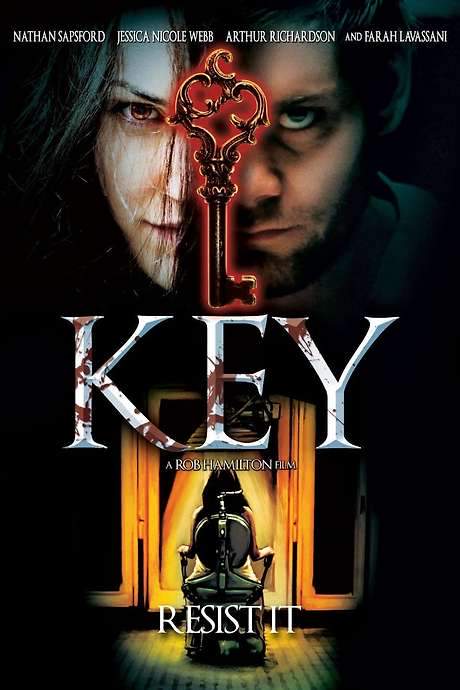
Key
Year: 2011
Runtime: 87 mins
Language: English
Director: Rob Hamilton
During a routine autopsy, forensic pathologist Martin Revell discovers a key lodged in the stomach of a man who apparently committed suicide. Intrigued, he pursues the key’s origin, and his obsession spirals into paranoia, madness and murders. The investigation forces him to confront his fragile sanity as he becomes entangled in a conspiracy.
Warning: spoilers below!
Haven’t seen Key yet? This summary contains major spoilers. Bookmark the page, watch the movie, and come back for the full breakdown. If you're ready, scroll on and relive the story!
Key (2011) – Full Plot Summary & Ending Explained
Read the complete plot breakdown of Key (2011), including all key story events, major twists, and the ending explained in detail. Discover what really happened—and what it all means.
The film opens with a stark, controlled challenge: a closed room, reinforced security, and a high-stakes examination for a coveted post at a prestigious company. Inside, nine candidates convene as an Invigilator explains the ground rules and the clock begins its 90-minute countdown. The room is sealed, the candidates must not speak to the Invigilator or to security, they may not leave, and they may not spoil their paper—intentionally or accidentally. The tension thickens when a blank sheet appears, minus any question, and one candidate is instantly disqualified for having scribbled the name of God on the page. The others stand in bewilderment, realizing that the challenge will be solved not by brute force, but by teamwork and clever deduction.
Deputy Jones, portrayed by Steve Brian, sits outside the room as the door is locked, while the nine contenders—each with a distinct professional identity—quietly prepare to navigate the impossible task ahead. The candidates introduce themselves and reveal their backgrounds to strip away bias: a Criminal Lawyer, a Professor, a Psychologist, an Optic Engineer, a Scientist, an MBA Graduate, a Business Consultant, and a Journalist. The sense of unity is tempered by the sting of rivalry as the group agrees to work within the rules and to use their diverse expertise to decipher the hidden question.
The group immediately turns to collaborative problem-solving, drawing on each member’s field to piece together clues. They test different approaches by manipulating light, analyzing bodily fluids, coordinating with fire sprinklers, and using glass fragments—each tactic designed to extract meaning from the room’s puzzling setup. Inevitably, tensions flare: the Optic Engineer is eliminated after tearing the paper, and the Criminal Lawyer begins to undermine the others by targeting the MBA Graduate and the Business Consultant, under the mistaken belief that manipulating the field will secure victory for himself. The Journalist strikes with force, seizing on the moment of chaos to disrupt the process and speed the path to a conclusion.
As the pressure mounts, the Psychologist—a figure who has inside knowledge of the firm’s culture—finds herself being pressed for answers about the “question,” and the invader-like scrutiny escalates. Time presses on, and the lawyer’s grip on the situation weakens. Yet the Professor remains steady, deftly managing crises and recovering the medicine the lawyer needs to avoid a dangerous decline. In a moment of cunning, the Lawyer wrests the guard’s revolver and issues a final warning to leave the room, escalating the peril. The Journalist reacts swiftly, and a shot is fired; the room is thrown into chaos as the Scientist exits and the Professor improvises a ruse to maintain control of the situation.
Amid the jolts of fear and adrenaline, the tension shifts from violent action to strategic maneuver. The Lawyer’s bold move is met with counterplay, and the room’s dynamics pivot on trust, deception, and the quick-witted responses of the survivors. The Journalist appears to be struck down, only for it to become clear that the bullet was a dummy—a ploy that reveals how easily appearances can mislead under pressure. The Invigilator arrives again, calm and composed, and ultimately offers a final verdict: the Professor has proven to possess the traits the company values—crisis management, composure under strain, and a cool, principled approach to leadership.
In the closing moments, the Invigilator declares that he does not ask any more questions; instead, the room’s contestants demonstrated their innate capabilities and how they perform under pressure when confronted with an unknown ordeal. The CEO’s ultimate decision crowns the Professor as the new leader, signaling that the winner is determined not by a single moment of luck, but by the sum of demonstrated skills—intellect, resilience, teamwork, and the ability to live up to a demanding, real-world standard.
The film closes with a quiet, confident note: the mission of the challenge was not to trap or trick the contenders, but to reveal what they could do when confronted with a crisis, and which among them would best guide the company forward. The Professor steps into the role with poise, and the Invigilator’s final affirmation underscores a theme that reverberates beyond the room: leadership comes from mastery of crisis, clarity of thought, and a proven capacity to navigate pressure with integrity.
Last Updated: November 22, 2025 at 15:59
Unlock the Full Story of Key
Don't stop at just watching — explore Key in full detail. From the complete plot summary and scene-by-scene timeline to character breakdowns, thematic analysis, and a deep dive into the ending — every page helps you truly understand what Key is all about. Plus, discover what's next after the movie.
Key Timeline
Track the full timeline of Key with every major event arranged chronologically. Perfect for decoding non-linear storytelling, flashbacks, or parallel narratives with a clear scene-by-scene breakdown.

Characters, Settings & Themes in Key
Discover the characters, locations, and core themes that shape Key. Get insights into symbolic elements, setting significance, and deeper narrative meaning — ideal for thematic analysis and movie breakdowns.



